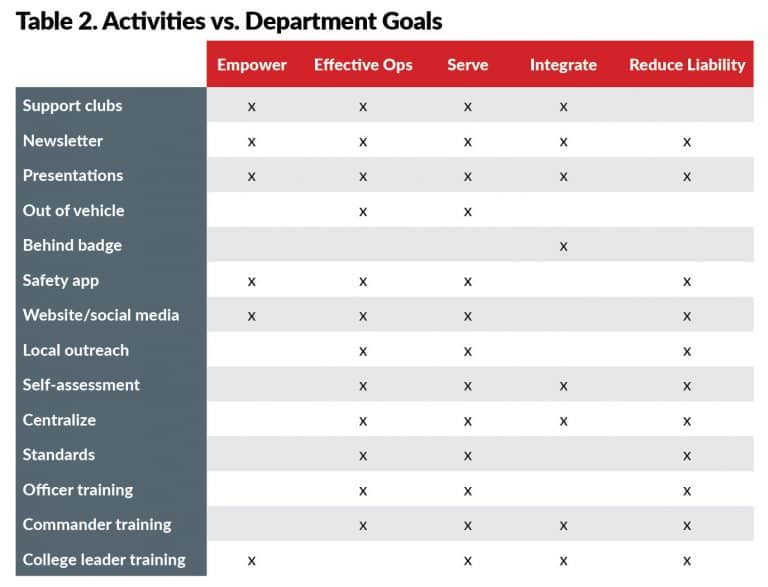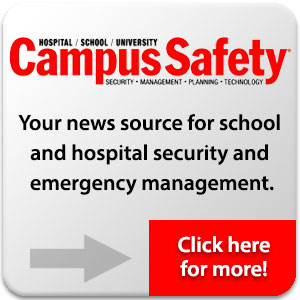Re-posted with permission from Campus Safety Magazine and edited.
Here’s how Northern Virginia Community College improved safety and decreased campus crime by adopting an approach that includes a wide range of community stakeholders. This is a continuation of last week’s post about proper campus support for first responders.
Integrate Campus Activities & Actors
The meaningful integration of campus entities with security responsibilities is advanced by the recognition that first responders are not exclusively about protection. It is counterproductive for police to be viewed as the strong-armed thugs who are kept in reserve except during emergencies.
As noted earlier, college police and security emphasize the service part of the “protect and serve” equation. Recognition of this service mentality is not only important for college-wide leadership; it is also a crucial priority for police leadership.
Most officers want to mix it up and “fight crime,” the reason why they got into law enforcement in the first place. It takes strong, articulate and determined leadership to encourage officers to recognize that protection and service are not mutually exclusive; instead, they are mutually reinforcing force multipliers.
Everyone reading this article knows that the campus public safety department by itself cannot discharge Clery, Title IX and VAWA responsibilities. Student services, mental health, HR, sexual assault services, deans, student services administrators and many others play a key role in implementing these important responsibilities. Similarly, “ownership” of security responsibilities among non-security personnel is critical.
However, there are other activities where first responders can and should play an integral role in college operations. For instance, the design of new campus buildings is usually driven by costs and aesthetics. Security considerations are seldom the primary focus of facilities planners.
Nevertheless, the amount of glass, the number of stories, the location of stairways and entrances/exits and the location of large structures (i.e., cover) that can protect against gunfire are important security factors that deserve consideration early in the planning stage.
Counter-terrorism is another example of the positive role integrated security can play. People with evil intentions will not reveal their activities to police or security, and shielding their nefarious activities is not difficult when one considers most campuses have but a few officers at any given time.
At the same time, parking, groundskeepers, facilities, emergency management and a host of other officials are ubiquitous on campus. Distribution of signs of terrorism, license plates of interest, etc., could be shared with these individuals by campus public safety. Facilities can also provide critical information on the hardness and vulnerabilities of key systems on campus that might constitute attractive targets for terrorists.
Similarly, fire alarms and elevator emergencies could be nothing at all, but they could also be rehearsals or tests to determine police response timelines and capabilities. In short, sensitizing others to potential security implications in their daily activities and timely information sharing with first responders can enhance situational awareness and synergistic response, and ultimately, campus safety and security.
Improved Campus Police & Security Operations
In college, one hears the old saw “everything is relative, relatively speaking.” Cultural relativism eschews recognition, let alone acceptance of unambiguous sets of behavioral standards. Even physics’ Heisenberg Indeterminacy Principle tells us one cannot measure something without interacting with it, calling into question objectivity and common perception.
It is through the establishment of behavioral standards, embodied in police and security general orders and standard procedures, the dissemination of campus-wide information about complaint procedures that hold officers accountable, rigorous initial certification and continuing certification requirements and performance standards, standardized (field) training for new officers, and continuing mandated professional development training that police ensure and maintain professionalism.
These standards and training offer a model of excellence applicable to all campus entities. Officers are held accountable, tasks are achieved, and professional development and growth are perpetual. This is but one example in which the police can make a positive contribution to the overall college community.
Officers also enhance their efficiency, effectiveness, and service to the college through rigorous self-assessment.
The key to this procedure is the identification of agency goals (either at the security agency level or for college writ large) evaluating which assets and resources (i.e., inputs) affect which goals, and of those that affect goals, their relative health. The execution of this self-evaluation gives an agency a measure of its successes, identifies areas where improvements are required and identifies which improvements should be pursued as priorities.
Finally, police, as well as various college actors such as sexual assault services and emergency management, can partner with local law enforcement agencies, social agencies and caregivers. Enhanced training, familiarity of local first responders with an institution’s layout and procedures and a knowledgeable and empowered campus community will contribute to enhanced campus safety and security.
Conduct a Systematic Analysis
There are many cost-effective strategies available to police and other college entities that can enhance safety and security on campus. However, a rigorous and systematic analysis of means and ends should be performed to develop these strategies. Table 2 is an example of such an analysis.
In this analysis, a monthly public safety newsletter and a program of campus-wide safety and security presentations provide the greatest returns; however, all 14 inputs listed (there are undoubtedly more) support the five listed security department and overall college goals.
Clearly, security challenges are too broad, too dynamic and too challenging to be dealt with exclusively by police. A college-wide, community approach to security can and will work wonders. From 2010 to 2016, crime at NOVA has been halved, declining from 310 to 159, and 2017’s crime rate was significantly lower than 2016’s.
There is nothing magical about NOVA’s successes. Their progress has not relied upon expensive equipment. Most of their solutions have been relatively inexpensive. The keys have been hard work, an analytical approach that bases decision-making on explicit priorities, marketing themselves as professionals committed to the college’s mission and a partnership with other campus offices.
Request an On-site ISG Consultation
The ISG provides campus security and safety solutions for colleges, universities, healthcare systems, government agencies and more, as well as crisis alert solutions for campus notification and communication with first responders. Contact us today to talk with your local ISG representative about solutions relevant to your campus needs.
Original article written by Chief Daniel Dusseau and Lt. John Weinstein for Campus Safety Magazine



